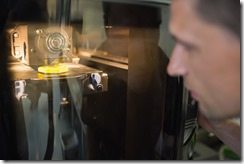Ford is partnering with 3D printing startup Carbon 3D to produce customized automotive parts, the car company announced. Inspired by the “liquid metal” cyborg in “Terminator 2,” Carbon 3D has developed a printing method that creates stronger materials than competitors at 100 times the speed. Ford wants to adapt this technology to create customized parts such as seats and steering wheels that fit the mold of your body.
3D printing applications such as this are multiplying at an accelerating rate, from customized toys and electronics gadgets to printable housing materials and even food. Most industries will be affected by 3D printing to some degree, with a few sectors leading the way and feeling the biggest direct impact.
Manufacturing
3D printing will turn manufacturing on its head. Whereas manufacturing once required a whole series of steps from making molds to product assembly, now it takes a single operation. Moreover, production no longer requires a central factory, but the process can now be executed at any printer location. This enables companies to use more flexible, cheaper supply chain sources and offer more customized products. Both prototypes and product lines can be produced faster than ever. Apple Rubber, a leading manufacturer of rubber o-rings and seals, is putting the benefits of 3D technology to use by enabling customers to order custom parts online and have them printed at a central in-house printer for easy prototyping and production.
Retail
3D printing is also revolutionizing the retail industry. For instance, a pair of eyeglasses that might cost $250 at a traditional eye doctor can be printed using 25 cents’ worth of materials. While some brands might find this prospect a challenge, others are capitalizing on the possibilities by forming licensing agreements and partnerships with 3D printing companies. For instance, DC Comics parent Warner Brothers has partnered with 3D Online Factory’s Lauzner.com to offer the first line of 3D-printed Batman figurines. Lauzner expects to expand this to feature the full line of DC superhero and Warner Looney Tunes characters. Disney, Marvel and Hasbro are also expanding into this growing retail space.
Shipping
3D printing’s impact on retail will spill over into the shipping industry. Strategy& predicts the commercial transportation industry will be disrupted as demand for shipping drops on items that lend themselves to local 3D printing, such as footwear, toys and ceramic products. Forty-one percent of air cargo and 37 percent of the ocean container shipments will be impacted, Strategy& anticipates, advising transportation companies to start revising their business models and exploring the new opportunities 3D printing represents.
Health Care
One of the most explosive and controversial applications of 3D printing will be the ability to print human tissue and organs for applications such as prosthetic limbs and artificial organs. While this represents great potential value for medical applications, it also raises ethical questions such as how to regulate quality control. Gartner projects that rapid developments in this field will spark major debates over 3D printing technology by 2016. Coupled with other applications of 3D printing technology, this will cause spending on 3D printers to grow from $1.6 billion in 2015 to $13.8 billion by 2018, Gartner predicts.


